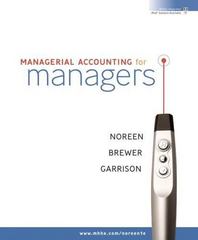Question
1. Scarlet Company owns 80% of Tamara Corp.'s common stock. During October 2019 Tamara sold merchandise to Scarlet for 125,000. At December 31, 2019, one-half
1. Scarlet Company owns 80% of Tamara Corp.'s common stock. During October 2019 Tamara sold merchandise to Scarlet for 125,000. At December 31, 2019, one-half of the merchandise remained in Scarlet inventory. For 2019, gross profit percentages were 30% for Scarlet and 40% for Tamara. The amount of unrealized intercompany profit in ending inventory at December 31, 2019 that should be eliminated in consolidation is:
20,000
25,000
50,000
18,750
2.A parent company regularly sells merchandise to its 80%-owned subsidiary. Which of the following statements describes the computation of non-controlling interest income?
A. (The subsidiary's net income + unrealized profits in the ending inventory - unrealized profits in the beginning inventory) x 20%
B. The subsidiary's net income + unrealized profits in the beginning inventory - unrealized profits in the ending inventory) x 20%
C. The subsidiary's net income x 20%) + unrealized profits in the beginning inventory- unrealized profits in the ending inventory
D. The subsidiary's net income times 20%
Non-controlling interest in consolidated income is never affected by
A.Downstream sales
B.Non-controlling interest is affected by all sales
C.Upstream Sales
D. Sale of Parent to unaffiliated company
Failure to eliminate intercompay sales would result in an overstatement of consolidated
A.Gross profit
B. Cost of sales
C. All of the above
D. Net income
The non-controlling interest in consolidated income when the selling affiliate is an 80% owned subsidiary is calculated by multiplying the non-controlling minority delete minority ownership percentage by the subsidiary's reported net income.
A.Less unrealized profit in ending inventory plus realized profit in beginning inventory
B. Less realized profit in ending inventory plus realized profit in beginning inventory.
C.Plus unrealized profit in ending inventory less unrealized profit in beginning inventory.
D.Plus realized profit in ending inventory less realized profit in beginning inventory
In determining controlling interest in consolidated income in the consolidated financial statements, unrealized intercompany profit on inventory acquired by a parent from its subsidiary should:
A.Be eliminated to the extent of the non-controlling interest in the subsidiary.
B.Be eliminated in full
C.Not be eliminated
D.Be eliminated to the extent of the parent company's controlling interest in the subsidiary
The material sale of inventory items by a parent company to an affiliated company
A.Enters the consolidated revenue computation only if the transfer was the result of arm's length bargaining
B.Does not require a working paper adjustment if the merchandise was transferred at cost.
C.Affects consolidated net income under a periodic inventory system but not under a perpetual inventory system.
D.Does not result in consolidated income until the merchandise is sold to outside parties.
In situations where there are routine inventory sales between parent companies and subsidiaries, when preparing the consolidation statements, which of the following line item is indifferent to the sales being either upstream or downstream?
A.Consolidated retained earnings
B.Consolidated gross profits
C.Non-controlling Interest expense
D. Consolidated net income
The work paper in the year of sale to eliminate unrealized intercompany profit in ending
A.Credit to Sales
B.Debit to Inventory - Balance Sheet
C.Credit to Ending Inventory (Cost of Sales)
D.Debit to Ending Inventory (Cost of Sales)
Sales from one subsidiary to another are called
A.Inter subsidiary sales
B.Downstream sales
C.Horizontal sales
D.Upstream sales
The consolidation procedures for intercompany sales are similar for upstream and downstreams sales
A.If the merchandise is immediately sold to outside parties
B.Under a periodic inventory system but not under a perpetual inventory system
C.If the merchandise is transferred at cost
D.When the subsidiary is 100% owned.
Step by Step Solution
There are 3 Steps involved in it
Step: 1

Get Instant Access to Expert-Tailored Solutions
See step-by-step solutions with expert insights and AI powered tools for academic success
Step: 2

Step: 3

Ace Your Homework with AI
Get the answers you need in no time with our AI-driven, step-by-step assistance
Get Started


